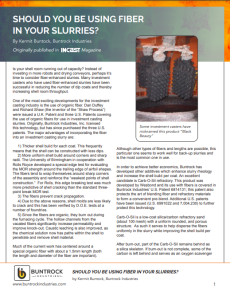Should You Be Using Fiber in Your Slurries?
Is your shell room running out of capacity? Instead of investing in more robots and drying conveyors, perhaps it’s time to consider fiber-enhanced slurries. Many investment casters who have used fiber-enhanced slurries have been successful in reducing the number of dip coats and thereby increasing shell room throughput.
One of the most exciting developments for the investment casting industry is the use of organic fiber. Dan Duffey and Richard Shaw (the inventor of the “Shaw Process”) were issued a U.K. Patent and three U.S. Patents covering the use of organic fibers for use in investment casting slurries. Originally, Buntrock Industries, Inc. licensed this technology, but has since purchased the three U.S. patents. The major advantages of incorporating the fiber into an investment casting slurry are:
- Thicker shell build for each coat. This frequently means that the shell can be constructed with less dips.
- More uniform shell build around corners and sharp radii. The University of Birmingham in cooperation with Rolls Royce developed a special edge test for evaluating the MOR strength around the trailing edge of airfoil shapes. The fibers tend to wrap themselves around sharp corners of the assembly and reinforce the “weakest points of shell construction.” For Rolls, this edge breaking test was much more predictive of shell cracking than the standard threepoint break MOR test.
- The fibers prevent crack propagation.
- Due to the above reasons, shell molds are less likely to crack and this has been verified by D.O.E. tests at a number of foundries.
- Since the fibers are organic, they burn out during the furnacing cycle. The hollow channels from the vacated fibers significantly increase permeability and improve knock-out. Caustic leaching is also improved, as the chemical solution now has paths within the shell to penetrate and remove shell material.
Much of the current work has centered around a special organic fiber with about a 1.5mm length (both the length and diameter of the fiber are important). Although other types of fibers and lengths are possible, this particular one seems to work well for back-up slurries and is the most common one in use.



